CARDIAC CATH LAB - Mount Sinai Hospital
CARDIAC CATH LAB - Mount Sinai Hospital
CARDIAC CATH LAB - Mount Sinai Hospital
You also want an ePaper? Increase the reach of your titles
YUMPU automatically turns print PDFs into web optimized ePapers that Google loves.
Developing a well-designed<br />
and well-supported<br />
technique for clearing<br />
CTOs has become the<br />
last frontier in PCI.<br />
Annapoorna S. Kini, MD<br />
Associate Director, Cardiac<br />
Cath Lab, on Percutaneous<br />
Coronary Intervention for<br />
Chronic Total Occlusion<br />
A chronic total occlusion (CTO) is a complex<br />
blockage of a coronary artery that has<br />
lasted for more than three months. CTOs<br />
are found in 15 to 20 percent of all patients<br />
undergoing coronary angiography. This<br />
subset of lesions has, up until now, proven<br />
to be the least amenable to recanalization<br />
through percutaneous coronary intervention<br />
(PCI), especially when the blockage is calcified<br />
or fibrotic and the obstruction is at an<br />
angulated location, making access more<br />
difficult. Consequently, the traditional<br />
guideline for treating patients with CTO<br />
remains coronary artery bypass surgery. But<br />
because PCI is far less invasive and recovery<br />
tends to be faster, developing a well-designed<br />
and well-supported technique for clearing CTOs has become the<br />
last frontier in percutaneous coronary intervention. <strong>Mount</strong> <strong>Sinai</strong>’s<br />
cath lab, a tertiary referral center with special expertise in complex<br />
coronary interventions, has been very much engaged in performing<br />
this task successfully.<br />
Before opening the blockage, we have to make sure that the heart<br />
muscle serving it is still alive and capable of recovery once the<br />
blockage is removed. A stress test or an MRI to check the viability<br />
of myocardium (a gold standard) may be necessary. The remarkable<br />
thing about chronic blockages that develop slowly (60 to 80 percent<br />
and finally 100 percent) as opposed to acute blockages is that<br />
during the gradual progression of a chronic blockage small-diameter<br />
collaterals can develop to maintain sufficient myocardial function.<br />
Often they do a good enough job that the patient is not even aware<br />
of the blockage until it is complete. After the blockage is removed<br />
the collaterals then regress and even wither away.<br />
20 <strong>Mount</strong> <strong>Sinai</strong> <strong>Hospital</strong> Cardiac Cath Lab



![December 2, 2012 [PDF] - Mount Sinai Hospital](https://img.yumpu.com/51092274/1/190x245/december-2-2012-pdf-mount-sinai-hospital.jpg?quality=85)
![January 21, 2013 [PDF] - Mount Sinai Hospital](https://img.yumpu.com/50916550/1/190x245/january-21-2013-pdf-mount-sinai-hospital.jpg?quality=85)

![February 3, 2013 [PDF] - Mount Sinai Hospital](https://img.yumpu.com/50584982/1/190x245/february-3-2013-pdf-mount-sinai-hospital.jpg?quality=85)
![March 18, 2012 [PDF] - Mount Sinai Hospital](https://img.yumpu.com/50462098/1/190x245/march-18-2012-pdf-mount-sinai-hospital.jpg?quality=85)



![Partners Program Guide [PDF] - Mount Sinai Hospital](https://img.yumpu.com/49411954/1/190x245/partners-program-guide-pdf-mount-sinai-hospital.jpg?quality=85)

![March 19 - April 1, 2012 [PDF] - Mount Sinai Hospital](https://img.yumpu.com/48990923/1/190x245/march-19-april-1-2012-pdf-mount-sinai-hospital.jpg?quality=85)
![PGY-1 Residency Application [PDF] - Mount Sinai Hospital](https://img.yumpu.com/48577701/1/190x245/pgy-1-residency-application-pdf-mount-sinai-hospital.jpg?quality=85)


